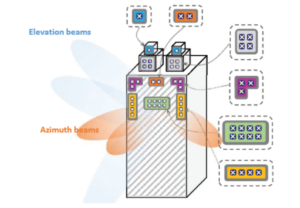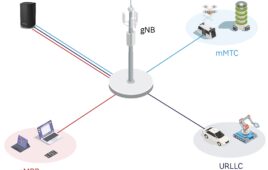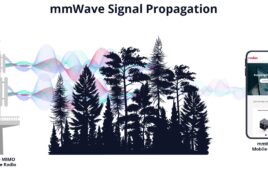In part 1, we discussed “Creating 5G Massive MIMO.” In part 2, we discuss the antenna options for moving into 6G using variations of Massive MIMO.
Massive MIMO (mMIMO) is a wireless communications technology that uses base stations equipped with very large numbers of antenna elements. These antennas improve spectral and energy efficiency. LTE-Advanced introduced advanced beamforming methods and massive MIMO (mMIMO) technology in base stations. That resulted in a higher and much more stable data rate in 5G’s mmWave transmission. Recent studies on 5G and 6G show how wireless carriers use MIMO in 5G’s 28 GHz mmWave bands. Going farther, 6G will have very high data rates that surpass 100 Gb/sec with through sub-terahertz frequencies of 100 GHz to 300 GHz. Beamforming technologies, which use mMIMO, can compensate for larger path loss in the higher frequency bands.

Figure 1. mMIMO systems typically may have tens, hundreds, or even thousands of antennas in a single antenna array. Image source: Mathworks.
Figure 1 shows that migration from MIMO to mMIMO.
Modular massive MIMO
Modular massive MIMO (mmMIMO) technology for 6G consists of one or more predefined basic antenna modules. Think Lego building blocks. This flexibility lets engineers connect antenna modules together to form a single system. Figure 2 shows an example.
Many experts say that mmMIMO — a distributed MIMO technology — could improve spectral efficiency in low-frequency (below 1 GHz) bands that could become part of 6G. These bands serve many users because of their wide coverage areas.

Figure 2. mMIMO systems typically may have tens, hundreds, or even thousands of antennas in a single antenna array. Image source: IEEE.
While mMIMO has a quite large active antenna array, mmMIMO has smaller standardized antenna modules that can be deployed in large, medium, or small groups. This flexibility will enable massive MIMO in the low-frequency bands under 1 GHz.
NTT DOCOMO has demonstrated that a combination of the distributed MIMO and the base-station cooperative transmission can stably achieve the high user throughput of more than 4 bps/Hz (400 Mb/sec) even in a high-mobility environment. Over 4 bps/Hz user throughput was shown to be stably achieved by 28 GHz band base-station cooperation with mMIMO for 5GE even at two mobile stations (MSs) at the high velocity of 90 km/h.
Enter massive Ultra-Reliable Low-Latency Communication (mURLLC)
6G wireless networks need to provide mURLLC services for massive subscribers. mMIMO techniques using massive antennas will greatly improve channel performance, thus achieving the goal of mURLLC networks.
Another 6G candidate technique, using an unmanned aerial vehicle (UAV), has been proposed to potentially support the mURLLC wireless networks. UAV significantly expands the signal’s line-of-sight (LOS) propagation with its flexibility to improve the wireless connection’s coverage.
Think of a cooperative UAV swarm as a dynamic antenna array that can maximize the wireless channel capacity by optimizing the position of each UAV. Unlike the fixed- and size-limited antenna array, the UAV swarm will achieve large apertures and will not be bounded by any geometry. Integrating the UAV with massive MIMO techniques will maximize the channel capacity only with the cost of moving the UAV from their initial positions and will guarantee the low-latency transmission for mURLLC traffic in supporting 6G wireless networks.
Other technologies such as beamforming and spatial multiplexing join massive MIMO as key technologies for 5G New Radio (NR) systems.
 Steve Taranovich is the author of Guardians of the Right Stuff. He’s an experienced technical writer and former editor-in-chief with a demonstrated history of working in the writing and editing industry. His skills include in analog electronics, space-related electronics, audio, RF communications, and power management. Steve holds BSEE and MSEE degrees from NYU Polytechnic School of Engineering (now NYU Tandon School of Engineering).
Steve Taranovich is the author of Guardians of the Right Stuff. He’s an experienced technical writer and former editor-in-chief with a demonstrated history of working in the writing and editing industry. His skills include in analog electronics, space-related electronics, audio, RF communications, and power management. Steve holds BSEE and MSEE degrees from NYU Polytechnic School of Engineering (now NYU Tandon School of Engineering).





Me interesa todo lo relacionado con las mejoras y alcances que ha tenido la tecnología 5g